Can you guess what movie or TV show we’re watching? We’ve turned on subtitles (when available) not to give you a clue, but to enhance that WTF effect! Leave your best guess in the comments to prove your true Flick Attackosity!
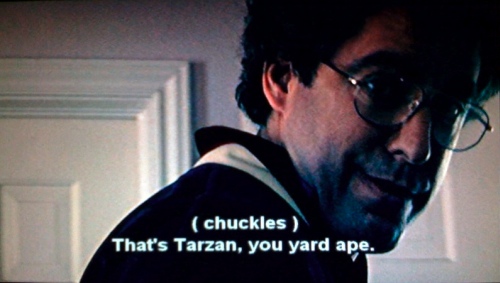
Can you guess what movie or TV show we’re watching? We’ve turned on subtitles (when available) not to give you a clue, but to enhance that WTF effect! Leave your best guess in the comments to prove your true Flick Attackosity!


 Yes, Yankee Doodle in Berlin is silent, but don’t go away. Let me tell you about it. It’s different. Really.
Yes, Yankee Doodle in Berlin is silent, but don’t go away. Let me tell you about it. It’s different. Really.
The picture stars Bothwell Browne, who was Danish and a female impersonator. (Note that you don’t have to be Scandinavian to be a female impersonator, but it helps. Just look at Garbo.) Anyway, Browne is Capt. Bob White of the American Army who accepts the job of infiltrating the German high command during WWI in the guise of a sexy woman. He will then vamp the Kaiser (Ford Sterling) and his son, the Crown Prince (Mal St. Clair), and seduce from them all their military secrets. Think of him as Mata Harry.
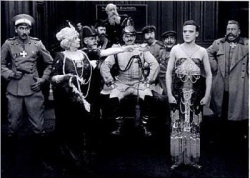 The comedy comes from shameless slapstick and the conceit that the Kaiser is nothing but a henpecked husband who is constantly under the thumb of his frau (Eva Thatcher). Add that to the propagandistic notion that Germany was being ruled by numbnuts and idiots (played by silent comedy stalwarts Ben Turpin, Chester Conklin, Bert Roach and others) and you have a fast-paced 58 minutes of funhouse slapstick that makes Mel Brooks look like Alan Rickman.
The comedy comes from shameless slapstick and the conceit that the Kaiser is nothing but a henpecked husband who is constantly under the thumb of his frau (Eva Thatcher). Add that to the propagandistic notion that Germany was being ruled by numbnuts and idiots (played by silent comedy stalwarts Ben Turpin, Chester Conklin, Bert Roach and others) and you have a fast-paced 58 minutes of funhouse slapstick that makes Mel Brooks look like Alan Rickman.
The picture was directed by F. Richard Jones and is pure Mack Sennett, loaded with pratfalls, mistaken identities, domineering women, seltzer bottles, sexual innuendo, collapsing beds and more goofy facial hair than a barber shop full of adolescent werewolves. Settle back to laugh, kick off your shoes, lower your brow, and pop the cap off a beer. Keystone, of course. —Doug Bentin

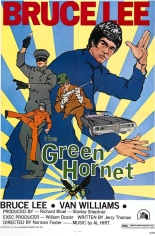 How can you tell The Green Hornet feature film is cobbled together from four episodes of the ’60s TV series? Because for about 20 minutes, our masked superhero (Van Williams) and his sidekick, Kato (Bruce Lee), are being targeted by the big city’s criminal bigwigs for assassination, and then — kablooey! — aliens from outer space (in the forms of humans donning costumes one level above Reynolds Wrap aluminum foil) burst through the wall. Cohesion and consistency, you are marked for death!
How can you tell The Green Hornet feature film is cobbled together from four episodes of the ’60s TV series? Because for about 20 minutes, our masked superhero (Van Williams) and his sidekick, Kato (Bruce Lee), are being targeted by the big city’s criminal bigwigs for assassination, and then — kablooey! — aliens from outer space (in the forms of humans donning costumes one level above Reynolds Wrap aluminum foil) burst through the wall. Cohesion and consistency, you are marked for death!
By day, The Green Hornet is wealthy newspaper publisher Britt Reid, and Kato is his chauffeur. The far-out space nuts comprise the largest piece of the story pie as they vie for control of a warhead, then suddenly — and finally — the action shifts to the Golden Lotus Cafe, the playground of the deadly Tongs and their kidnapping and extortion racket.
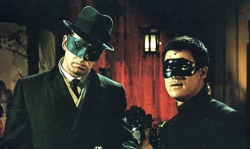 Hornet was birthed as another Batman, but eschews that series’ playfulness for a more straightforward approach. I wouldn’t exactly call it gritty, but the emphasis is on crime rather than clowning around, with the added pleasure of kung fu. Williams is generic is both line delivery and pretty-boy looks, but likable enough. Lee is, of course, Lee, Supreme Ass-Kicker of the World, and to the surprise of nobody, the biggest asset of this superheroic feature.
Hornet was birthed as another Batman, but eschews that series’ playfulness for a more straightforward approach. I wouldn’t exactly call it gritty, but the emphasis is on crime rather than clowning around, with the added pleasure of kung fu. Williams is generic is both line delivery and pretty-boy looks, but likable enough. Lee is, of course, Lee, Supreme Ass-Kicker of the World, and to the surprise of nobody, the biggest asset of this superheroic feature.
Your best bet for grabbing this film and its 1976 sequel, Fury of the Dragon, plus all the episodes, the two crossover eps from Batman, the 1940s serial and a slew of extras, look no further than the four-disc Ultimate Collection import. Since the series — not to mention Batman as well — isn’t yet licensed for stateside release, it’s a steal. —Rod Lott

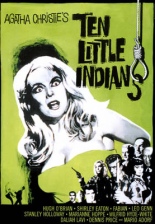 Agatha Christie’s classic novel And Then There Were None has been adapted for the screen many times, but none more swingin’ than schlockmeister Harry Alan Towers’ 1965 production, Ten Little Indians. This version is inferior to the first and best, 1945’s And Then There Were None, directed by René Clair, but don’t let that dissuade you.
Agatha Christie’s classic novel And Then There Were None has been adapted for the screen many times, but none more swingin’ than schlockmeister Harry Alan Towers’ 1965 production, Ten Little Indians. This version is inferior to the first and best, 1945’s And Then There Were None, directed by René Clair, but don’t let that dissuade you.
Christie’s amazingly influential premise is directly ported onto screen as 10 strangers — a doctor, a judge, an actress, a singer, etc. — are summoned to a weekend in the mountaintop mansion of one Mr. U.N. Owen, a host none of them know. They’re awaiting his arrival when a recording of his voice (a disembodied Christopher Lee) accuses each of them of having commited murder of an innocent. Their punishment is getting murdered in turn, as they’re trapped in the estate until Monday.
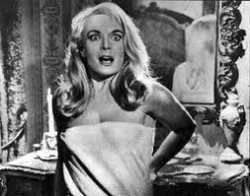 Not long after they notice the presence of the “Ten Little Indians” nursery rhyme all over the rooms, one of them dies, and in the exact manner as the rhyme’s first couplet. Just who is this Mr. Owen? Why is he doing this? And will they be able to find out before there are none of them left? You’ll have a ball being stumped.
Not long after they notice the presence of the “Ten Little Indians” nursery rhyme all over the rooms, one of them dies, and in the exact manner as the rhyme’s first couplet. Just who is this Mr. Owen? Why is he doing this? And will they be able to find out before there are none of them left? You’ll have a ball being stumped.
Only in the ’60s would teen idol Fabian be cast, making some of the strangest facial expressions the screen wouldn’t see the likes of until Daniel Day-Lewis in My Left Foot. Only in the ’60s would the lead roles be given to featherweight actors like Hugh O’Brian and former Bond girl Shirley Eaton (who, however, disrobes twice). And only in the ’60s would it be given a William Castle-esque gimmick in the form of a “Whodunit Break,” a minute-long intermission during which a clock countdowns the seconds, shows you clues and invites you to figure out the solution beforehand. —Rod Lott

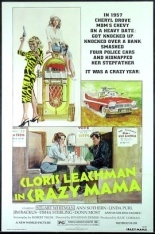 Cloris Leachman has specialized in playing grotesques and weird old ladies for so long, it’s easy to forget that she originally came to Hollywood as just another blond beauty queen. For those of us who knew her first as Young Frankenstein’s Frau Blücher, it’s hard to reconcile her as the same actress who just five years earlier played the cute hooker in Butch Cassidy and the Sundance Kid.
Cloris Leachman has specialized in playing grotesques and weird old ladies for so long, it’s easy to forget that she originally came to Hollywood as just another blond beauty queen. For those of us who knew her first as Young Frankenstein’s Frau Blücher, it’s hard to reconcile her as the same actress who just five years earlier played the cute hooker in Butch Cassidy and the Sundance Kid.
Which is what makes watching her in the flawed comedy Crazy Mama — her first starring feature — such a strange experience, since it finds her right at the crossroads of what she once was and what she would eventually become. Playing a ’50s-era evicted beauty salon owner who decides to fund her return to her Arkansas hometown by committing a series of robberies along the way, she plays the role far too shrill and eccentrically to ever earn our sympathies, but remains compelling enough to keep you watching nonetheless.
 Most of the film’s problems with volume and tone can be blamed on a young Jonathan Demme, who at this point in his career hadn’t developed the sure hand at comedy he would later show with Handle with Care, Melvin and Howard and Married to the Mob. Crazy Mama often feels like an early prototype of those films — the one he had to fuck up in order to know what not to do in the future.
Most of the film’s problems with volume and tone can be blamed on a young Jonathan Demme, who at this point in his career hadn’t developed the sure hand at comedy he would later show with Handle with Care, Melvin and Howard and Married to the Mob. Crazy Mama often feels like an early prototype of those films — the one he had to fuck up in order to know what not to do in the future.
Still, there are some definite bright spots in this low-budget New World production. Linda Purl (Visiting Hours) is about as cute as human beings come in the role of Leachman’s pregnant daughter, and she has great chemistry with her co-star, Happy Days’ Donny Most. And, like all of Demme’s comedies, the film has a tragic undercurrent lingering beneath its laughs, which gives it enough resonance to make sitting through the weaker moments worth the effort. —Allan Mott